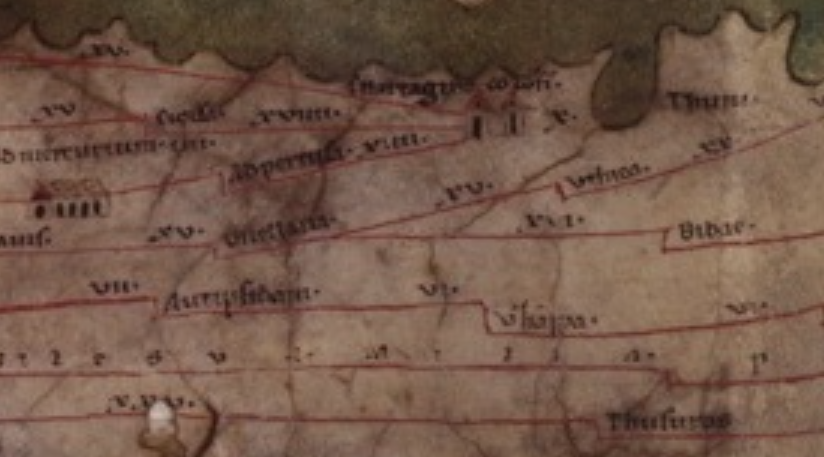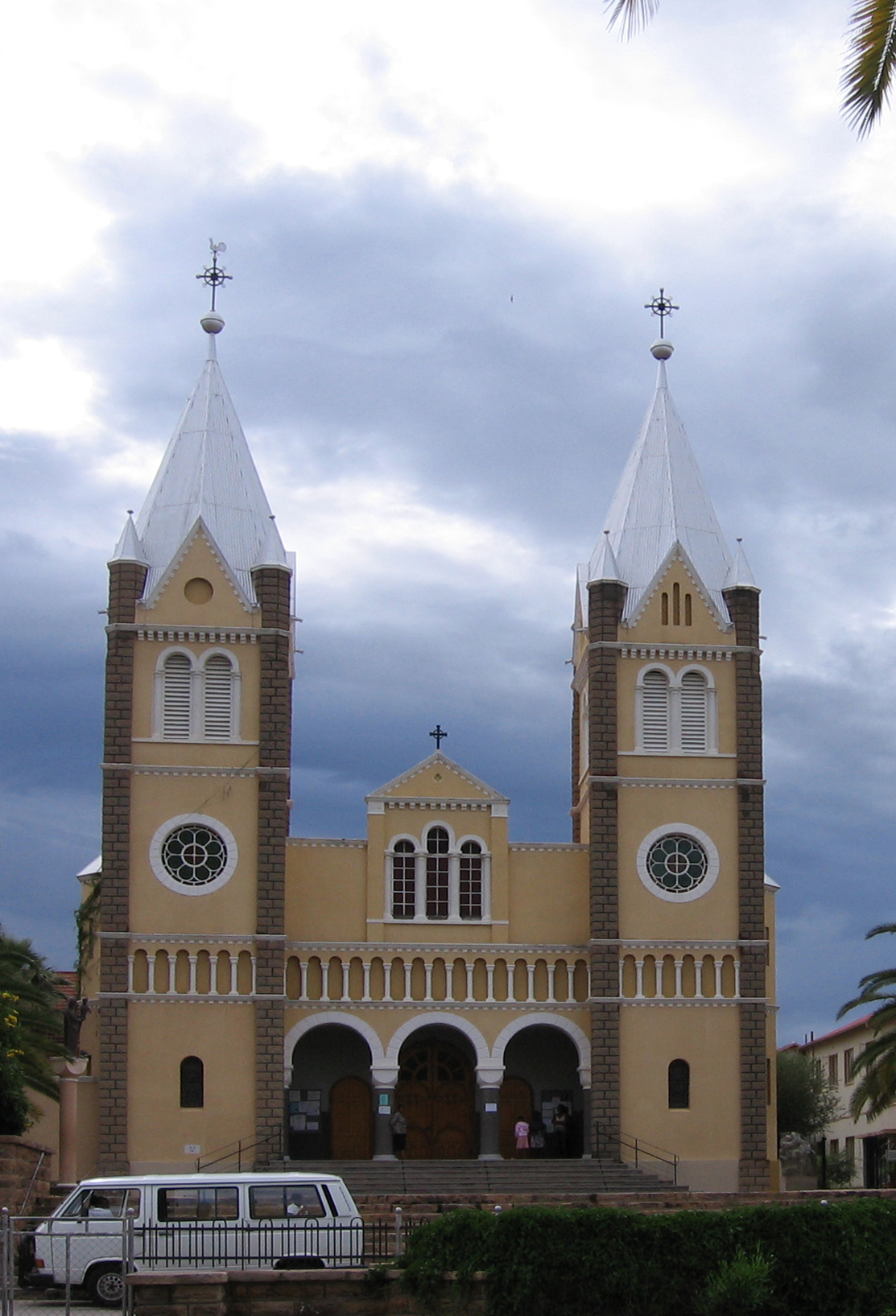|
Pertusa (Africa)
Pertusa was an ancient city and diocese in Tunisia. It is now a Catholic titular bishopric. History The Bishopric of Ad Pertusa was centered on the ancient Roman civitas of Pertvsa, which has been identified with ruins at modern El-Haraïria, an outer suburb of Tunis. During the Roman Empire Pertusa was located in the Roman province of Africa Proconsularis and was important enough to become a bishopric, which was suffragan to the nearby Metropolitan, of Carthage. The town is mentioned in the Antonini Itinerarium.Bernd Löhberg, Das "Itinerarium provinciarum Antonini Augusti": (Frank & Timme GmbH, 2006 p80 Titular see It was nominally revived in 1933 as a Latin titular see of the lowest (episcopal) in 1933, and has almost constantly been awarded. Its incumbents were mostly secular priests : * Giorgio Giuseppe Haezaert, Spiritans (C.S.Sp.) (1935.06.18 – 1957.09.29), as first Apostolic Vicar of Northern Katanga (in then Belgian Congo) * Leonard Philip Cowley (1957.11.28 ... [...More Info...] [...Related Items...] OR: [Wikipedia] [Google] [Baidu] |
Diocese
In Ecclesiastical polity, church governance, a diocese or bishopric is the ecclesiastical district under the jurisdiction of a bishop. History In the later organization of the Roman Empire, the increasingly subdivided Roman province, provinces were administratively associated in a larger unit, the Roman diocese, diocese (Latin ''dioecesis'', from the Greek language, Greek term διοίκησις, meaning "administration"). Christianity was given legal status in 313 with the Edict of Milan. Churches began to organize themselves into Roman diocese, dioceses based on the Roman diocese, civil dioceses, not on the larger regional imperial districts. These dioceses were often smaller than the Roman province, provinces. Christianity was declared the Empire's State church of the Roman Empire, official religion by Theodosius I in 380. Constantine the Great, Constantine I in 318 gave litigants the right to have court cases transferred from the civil courts to the bishops. This situ ... [...More Info...] [...Related Items...] OR: [Wikipedia] [Google] [Baidu] |
Antonini Itinerarium
The Antonine Itinerary ( la, Itinerarium Antonini Augusti, "The Itinerary of the Emperor Antoninus") is a famous '' itinerarium'', a register of the stations and distances along various roads. Seemingly based on official documents, possibly from a survey carried out under Augustus, it describes the roads of the Roman Empire. Owing to the scarcity of other extant records of this type, it is a valuable historical record. Almost nothing is known of its date or author. Scholars consider it likely that the original edition was prepared at the beginning of the 3rd century. Although it is traditionally ascribed to the patronage of the 2nd-century Antoninus Pius, the oldest extant copy has been assigned to the time of Diocletian and the most likely imperial patron—if the work had one—would have been Caracalla. ''Iter Britanniarum'' The British section is known as the ''Iter Britanniarum'', and can be described as the ' road map' of Roman Britain. There are 15 such i ... [...More Info...] [...Related Items...] OR: [Wikipedia] [Google] [Baidu] |
Apostolic Administrator
An Apostolic administration in the Catholic Church is administrated by a prelate appointed by the pope to serve as the ordinary for a specific area. Either the area is not yet a diocese (a stable 'pre-diocesan', usually missionary apostolic administration), or is a diocese, eparchy or similar permanent ordinariate (such as a territorial prelature or a territorial abbacy) that either has no bishop (an apostolic administrator ''sede vacante'', as after an episcopal death or resignation) or, in very rare cases, has an incapacitated bishop (apostolic administrator ''sede plena''). Characteristics Apostolic administrators of stable administrations are equivalent in canon law with diocesan bishops, meaning they have essentially the same authority as a diocesan bishop. This type of apostolic administrator is usually the bishop of a titular see. Administrators ''sede vacante'' or ''sede plena'' only serve in their role until a newly chosen diocesan bishop takes possession of the dioc ... [...More Info...] [...Related Items...] OR: [Wikipedia] [Google] [Baidu] |
Namibia
Namibia (, ), officially the Republic of Namibia, is a country in Southern Africa. Its western border is the Atlantic Ocean. It shares land borders with Zambia and Angola to the north, Botswana to the east and South Africa to the south and east. Although Kazungula, it does not border Zimbabwe, less than 200 metres (660 feet) of the Botswanan right bank of the Zambezi, Zambezi River separates the two countries. Namibia gained independence from South Africa on 21 March 1990, following the Namibian War of Independence. Its capital and largest city is Windhoek. Namibia is a member state of the United Nations (UN), the Southern African Development Community (SADC), the African Union (AU) and the Commonwealth of Nations. The driest country in sub-Saharan Africa, Namibia has been inhabited since pre-historic times by the San people, San, Damara people, Damara and Nama people. Around the 14th century, immigration, immigrating Bantu peoples arrived as part of the Bantu expansion. Since ... [...More Info...] [...Related Items...] OR: [Wikipedia] [Google] [Baidu] |
Roman Catholic Archdiocese Of Windhoek
The Roman Catholic Archdiocese of Windhoek ( la, Vindhoeken(sis)) is the Metropolitan See for the Ecclesiastical province of Windhoek in Namibia. The predecessor to the current Archdiocese, the Prefecture Apostolic of Cimbebasia, was established in 1892 and the current archdiocese was fully erected in March 1994. The current archbishop is Liborius Ndumbukuti Nashenda. History * August 1, 1892: Established as Apostolic Prefecture of Lower Cimbebasia from the Apostolic Prefecture of Cimbebasia in Angola * January 10, 1921: Renamed as Apostolic Prefecture of Cimbebasia * May 11, 1926: Promoted as Apostolic Vicariate of Windhoek * March 14, 1994: Promoted as Metropolitan Archdiocese of Windhoek Special churches * The cathedral is St. Mary's Cathedral in Windhoek. Bishops * Prefect Apostolic of Lower Cimbebasia (Roman rite) ** Fr. Bernard Pierre Herrmann, O.M.I. (1892 – 1901) ** Fr. Augustine Nachtwey, O.M.I. (1901.12 – 1908) ** Fr. Joseph Schemmer, O.M.I. (1908.11.24 – 1 ... [...More Info...] [...Related Items...] OR: [Wikipedia] [Google] [Baidu] |
Missionary Oblates Of Mary Immaculate
The Missionary Oblates of Mary Immaculate (OMI) is a missionary religious congregation in the Catholic Church. It was founded on January 25, 1816, by Eugène de Mazenod, a French priest born in Aix-en-Provence in the south of France on August 1, 1782, who was to be recognized later as a Catholic saint. The congregation was given recognition by Pope Leo XII on February 17, 1826. , the congregation was composed of 3,631 priests and lay brothers usually living in community. Oblate means a person dedicated to God or God's service. Their traditional salutation is ("Praised be Jesus Christ"), to which the response is ("And Mary Immaculate"). Members use the post-nominal letters, "OMI". As part of its mission to evangelize the "abandoned poor", OMI are known for their mission among the Indigenous peoples of Canada, and their historic administration of at least 57 schools within the Canadian Indian residential school system. Those oblate schools have been associated with many cases ... [...More Info...] [...Related Items...] OR: [Wikipedia] [Google] [Baidu] |
Roberto Rodríguez (bishop)
Roberto Rodríguez (August 14, 1936 – July 3, 2021) was an Argentine Roman Catholic prelate. He served as the titular bishop of Pertusa from 1992 to 1998 and the fourth Bishop of the Roman Catholic Diocese of Villa María in Argentina from 1998 to 2006. He was then appointed the sixth Bishop of the Roman Catholic Diocese of La Rioja by Pope John Paul II, a position he held from 2006 until his retirement on July 9, 2013. Rodríguez was born in Temperley district, Greater Buenos Aires, on August 14, 1936. He was ordained as a Catholic priest on January 31, 1970, in the town of Cosquín, by the Archbishop of Córdoba Raúl Francisco Primatesta. He later completed a theology degree at Pontifical Gregorian University. Roberto Rodríguez, the Bishop Emeritus of La Rioja, died from COVID-19 Coronavirus disease 2019 (COVID-19) is a contagious disease caused by a virus, the severe acute respiratory syndrome coronavirus 2 (SARS-CoV-2). The first known case was COVID-19 pan ... [...More Info...] [...Related Items...] OR: [Wikipedia] [Google] [Baidu] |
Apostolic Vicariate Of Northern Katanga
The Roman Catholic Diocese of Kongolo ( la, Kongoloën(sis)) is a Latin suffragan diocese in the Ecclesiastical province of Lubumbashi in the Democratic Republic of the Congo. Its cathedral episcopal see is Cathédrale Sacré-Coeur-de-Marie (dedicated to Our Lady's Heart) in the city of Kongolo. History * Established on June 30, 1911 as Apostolic Prefecture of Northern Katanga, on territory split off from the then Apostolic Vicariate of Léopoldville * Promoted on June 18, 1935 as Apostolic Vicariate of Northern Katanga, hence entitled to a titular bishop * Renamed March 8, 1951 as Apostolic Vicariate of Kongolo, after its see * Lost territory on 23 April 1956 to establish the then Apostolic Vicariate of Kindu * Promoted on November 10, 1959 as Diocese of Kongolo, no longer missionary nor exempt * Lost territory on 10 March 1966 to the Diocese of Kabinda * Gained territory on 8 May 1971 from the Diocese of Baudouinville (now Kalemie–Kirungu) * Lost territory on 31 ... [...More Info...] [...Related Items...] OR: [Wikipedia] [Google] [Baidu] |
Apostolic Vicar
Apostolic may refer to: The Apostles An Apostle meaning one sent on a mission: *The Twelve Apostles of Jesus, or something related to them, such as the Church of the Holy Apostles *Apostolic succession, the doctrine connecting the Christian Church to the original Twelve Apostles *The Apostolic Fathers, the earliest generation of post-Biblical Christian writers *The Apostolic Age, the period of Christian history when Jesus' apostles were living *The '' Apostolic Constitutions'', part of the Ante-Nicene Fathers collection Specific to the Roman Catholic Church *Apostolic Administrator, appointed by the Pope to an apostolic administration or a diocese without a bishop *Apostolic Camera, or "Apostolic Chamber", former department of finance for Papal administration * Apostolic constitution, a public decree issued by the Pope *Apostolic Palace, the residence of the Pope in Vatican City *Apostolic prefect, the head of a mission of the Roman Catholic Church *The Apostolic See, sometimes us ... [...More Info...] [...Related Items...] OR: [Wikipedia] [Google] [Baidu] |
Spiritans
, image = Holy Ghost Fathers seal.png , size = 175px , caption = The seal of the Congregation depicting the Immaculate Heart of Mary, and the Holy Spirit proceeding from the Trinity. , abbreviation = CSSp , nickname = Spiritan , formation = , founding_location = Paris, France , founder = Claude-François Poullart des Places, CSSp , type = Clerical Religious Congregation of Pontifical Right for Men , headquarters = Rome, Italy , region_served = Europe, North America, Australia, the Indian Ocean and Africa. , membership = 2,794 members (2,109 priests) as of 2018 , leader_title = Motto , leader_name = la, Cor unum et anima unaEnglish:''One heart and one spirit'' , leader_title2 = Superior General , leader_name2 = Alain Mayama, CSSp , main_organ = , affiliation = Roman Catholic Church , website ... [...More Info...] [...Related Items...] OR: [Wikipedia] [Google] [Baidu] |
Titular See
A titular see in various churches is an episcopal see of a former diocese that no longer functions, sometimes called a "dead diocese". The ordinary or hierarch of such a see may be styled a "titular metropolitan" (highest rank), "titular archbishop" (intermediary rank) or "titular bishop" (lowest rank), which normally goes by the status conferred on the titular see. Titular sees are dioceses that no longer functionally exist, often because the territory was conquered by Muslims or because it is schismatic. The Greek–Turkish population exchange of 1923 also contributed to titular sees. The see of Maximianoupolis along with the town that shared its name was destroyed by the Bulgarians under Emperor Kaloyan in 1207; the town and the see were under the control of the Latin Empire, which took Constantinople during the Fourth Crusade in 1204. Parthenia, in north Africa, was abandoned and swallowed by desert sand. Catholic Church During the Muslim conquests of the Middle Eas ... [...More Info...] [...Related Items...] OR: [Wikipedia] [Google] [Baidu] |





